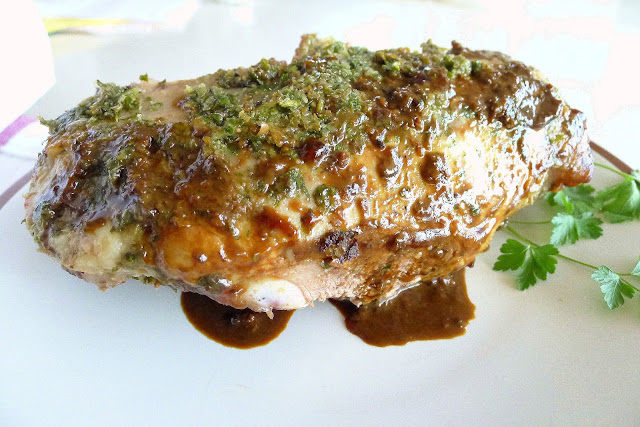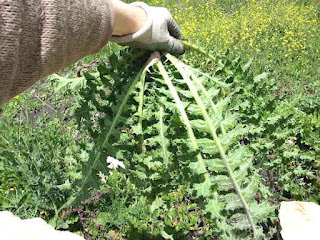Fresh green shoots appear in the pots of parsley, mint and chives on my patio, while fronds of wild fennel pop up from the earth near the vegetable patch. Spring is springing forth!
I love using fresh green herbs lavishly, in cooked dishes and in salads. Besides parsley, mint, chives and fennel, other herbs that signal springtime are dill, cilantro, tarragon, chervil, celery leaves and garlic scapes.
 |
| Fresh parsley and mint--and a tiny snail in the center. |
In Spanish cooking, parsley (
perejil) is absolutely the favorite herb of all. At the market where I shop, a big bunch of flat-leaf parsley is often tucked in with the fruits and vegetables as a gift. It is used, not just as a verdant garnish for a finished dish, but as an important ingredient, imparting a fresh grassiness to meatballs, stews, marinades, salads, fish sauces.
Mint (
hierbabuena) is arguably the second most-used herb. It’s the finishing touch for any soup with ham bone or rich sausages, with fish soups and casseroles, with spring vegetables such as artichokes, peas and fava beans. Ferny fennel fronds, with their sweet anise flavor, also are chopped up into vegetable dishes. (Other recipes with fresh herbs are linked at the end of this post.)
Herbal how-to. Wash bunches of parsley under running water. Shake off excess water, then roll it in kitchen towel and pat dry. Store the parsley in a plastic bag in the crisper drawer of fridge. Cut away stems before chopping (stems can be used for soup stock). To chop parsley, scrunch it tightly into a ball and chop. Mint can be stored in a glass of water or, unwashed, in a plastic bag in the fridge. Wash it and pat dry before using. Strip the leaves off the stems.
 |
| Potatoes in green sauce. |
|
|
 |
| Serve the potatoes as a side dish or as a starter. |
Potatoes in Green Sauce
Patatas en Salsa Verde
These potatoes can be served as a side dish or as a starter. As a starter, they may have chopped egg and even a few shrimp added. They are usually prepared with regular potatoes, cut in thick slices. I’ve played up the spring theme by using tiny new potatoes.
Spring onions or “green” onions (cebolletas in Spanish) are immature onions along with their green tops. They’re fatter than scallions, which could be substituted.
 |
| Spring onions, new potatoes. |
Serves 6.
2 pounds small new potatoes
3 tablespoons olive oil
½ cup chopped spring onions
3 cloves garlic, chopped
1 cup chicken or fish stock or water
1/3 cup white wine
¾ cup chopped parsley
Salt and pepper
Hard-cooked egg (optional)
Cut the potatoes in halves or quarters. In a pan or cazuela, heat the oil and sauté the onion and garlic until softened, 3 minutes. Add the potatoes, turning them in the oil so they don’t brown.
Add the water or stock and wine. Add ½ cup of the chopped parsley. Bring to a boil, then reduce to a simmer. Season with salt (if using stock, less salt will be needed) and pepper and cook, partially covered, until the potatoes are tender, about 20 minutes. Shake the pan occasionally to prevent sticking.
Garnish with remaining chopped parsley and chopped egg, if desired.
Roast Lamb with Spring Herbs
Cordero Asado con Hierbas
 |
| Herb marinade makes a tasty sauce for roast leg of lamb. |
 |
| Sliced lamb with herb sauce. |
 |
| Mini-processor to make marinade. |
1 medium onion, coarsely chopped
6 cloves garlic
½ cup chopped parsley
¼ cup mint leaves
2 tablespoons chopped fennel leaves
1 tablespoon fresh rosemary
2 strips lemon zest, chopped
½ teaspoon salt
Freshly ground black pepper
2 tablespoons olive oil
Leg of lamb (about 3 pounds)
Use a mini-processor to grind together the onion, garlic, parsley, mint, fennel, rosemary, lemon zest, salt and pepper. Mix in the oil.
Spread the parsley paste on all sides of the lamb. Allow to marinate, refrigerated, for up to 8 hours. Bring the lamb to room temperature before roasting. Place it in a roasting pan.
Preheat oven to 375ºF. Roast the lamb for 15 minutes. Reduce oven temperature to 325ºF. Continue roasting until lamb is medium-rare, 145ºF internal temperature, tested with an instant-read thermometer.
Allow the meat to rest 10 minutes before slicing. Add a little water or stock to the roasting pan and scrape up all the drippings. Serve the sauce with the lamb.
Cucumber, Cheese and Mint Salad
Ensalada de Pepino y Queso Fresco con Hierbabuena
 |
| Chopped cucumber, white cheese and mint for a fresh spring salad. |
Queso fresco is a soft, uncured, fresh, mild-flavored cheese, usually of goat’s milk, that can be cut into dice. If not available, use feta, but use less salt in the salad.
1 cup peeled and diced cucumber
2 tablespoons diced radish
2 tablespoons diced celery with some of the leaf
2 tablespoons diced scallions or spring onions
1 cup diced queso fresco or feta
2 tablespoons extra virgin olive oil
2 teaspoons fresh lemon juice
½ teaspoon salt
Freshly ground black pepper
2 tablespoon chopped fresh mint
Salad greens to serve
In a bowl combine the cucumber, radish, celery and scallions. Shortly before serving add the diced cheese, oil, lemon juice, salt and pepper. Add the chopped mint and mix gently. Serve with salad greens.
 |
| Fava beans, peas, ham and mint. Recipe is here. |
More recipes with fresh herbs:





































